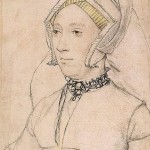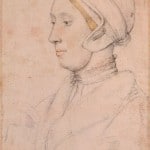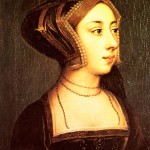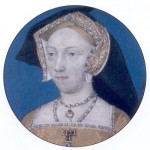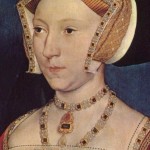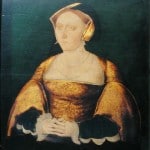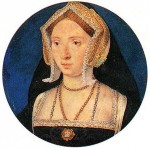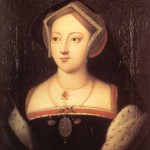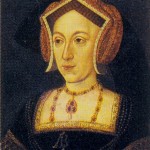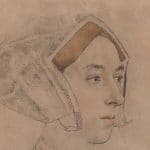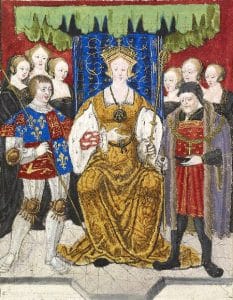 You may remember that last week I shared an article by art historian and author Roland Hui regarding an image from The Black Book of the Garter attributed to Lucas Horenbout, which Roland Hui believed might well be Anne Boleyn. Roland made the following points:
You may remember that last week I shared an article by art historian and author Roland Hui regarding an image from The Black Book of the Garter attributed to Lucas Horenbout, which Roland Hui believed might well be Anne Boleyn. Roland made the following points:
- The Black Book was created in 1534, while Henry VIII was married to Anne Boleyn
- The large circular pendant worn by the queen consort in the image had golden letters A and R – Anna Regina, Anne the Queen.
- The queen in question is not wearing medieval costume, as she would be if she was Philippa of Hainault, wife of Edward III, but is wearing typical dress of the 1530s and her ladies are wearing French hoods from that period. The dress is also very similar to one worn by Jane Seymour in a portrait.
- Although the Lady of the Garter title had died out, Horenbout could have been “creating a backdrop where he could pay tribute to the present Queen by having her stand in for Philippa”.
You can read more in Roland’s article at https://tudorfaces.blogspot.com.es/2017/04/anne-boleyn-as-lady-of-garter.html.
An article disputing Roland’s views has just been published on QueenAnneBoleyn.com – see http://queenanneboleyn.com/2017/05/03/really-anne-boleyn-r-e-bruyere/ and the main points made are:
- Henry VIII would surely have had the image removed from The Black Book if it was of Anne Boleyn
- That 1534 was not a triumphant year for Anne so there would be no reason to depict her in the book.
- That the title Lady of the Garter was not used in Henry VIII’s reign.
- That the woman depicted has blond hair.
- That the AR could stand for “Anglia Regina”, Queen of England, and could therefore be Jane Seymour or Anne of Cleves.
Some interesting points, but the one about the blond hair is irrelevant as if you zoom in on the image then it can be clearly seen that no hair is showing. The gable hood was not supposed to show any hair – as opposed to the more risque French hood – and what you can see in the image at the forehead is the band of the hood. Here are some images of women wearing gable hoods (or just a coif in one) where you can see the band clearly:
and here is a zoom-in on the head from the Lady of the Garter image:
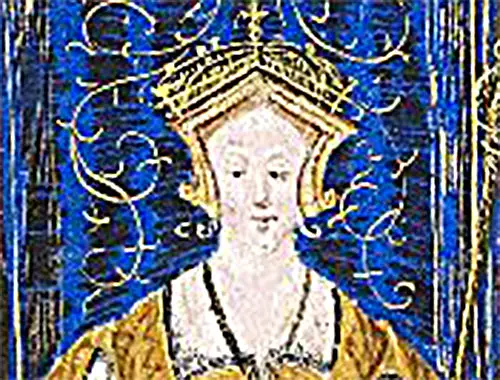
Regarding the AR standing for “Anglia Regina”, I’ve never come across any of Henry VIII’s queen consorts using “AR” to stand for that. From what I have seen, they used their first initial and then “R” for “Regina” (AR, KR etc.) and the king used “HR” for Henry/Henricus Rex. I’ve seen medieval kings use Rex Anglicus so wouldn’t it be more natural for it to be Regina Anglica/Anglia/Angliae, so RA, like “Katerina Regina Anglia & Francia”? I’ve only ever seen Anglia/Angliae Regina used in a longer title, not as a stand-alone title or intials, e.g. “Dei gratia Angliæ, Franciæ & Hiberniæ Regina, fidei defensor…”. Heraldry and Latin titles are not my forte though!
Lucy Churchill, who researched images of Anne Boleyn when she was recreating the 1534 medal, notes the use of the imperial crown in the image:
“It is interesting to note the Imperial Crown above the gable hood worn by Anne Boleyn in her depiction as Queen Phillipa. This inclusion demonstrates Henry’s increasing bid during the 1530s to claim precedent for the English king’s absolute power within the realm, including total authority over the Church in England, in defiance of the Church of Rome. As his anointed queen Anne shared this God-given right, and so would the child that she was carrying when this illustration was made. You can see Henry and Anne’s prevalent use of the Imperial Crown in the King’s College Chapel choirscreen, also created at this time. The claim to imperial power delivers the potent message of intent that Henry and Anne were formulating towards the Church of Rome, and those still adhering to its authority.”
Interesting! Lucy has also pointed out that the 1534 medal is not the only contemporary image we have as there is also that rather cartoon-like likeness of Anne on the plan for her coronation feast. It depicts her wearing the imperial crown. Thank you, Lucy for your input! See https://lucychurchill.wordpress.com/2012/05/14/the-moost-happi-portrait-of-anne-boleyn-a-rec/ for more on Lucy’s reconstruction of the medal.
What do I think about it all?
Well, I’m not 100% sure, but I find it interesting that the sitter is wearing 1530s costume, and therefore is unlikely to be Philippa of Hainault, and that she is depicted wearing a pendant with “AR”. I think it could well have been produced at the same time as the 1534 medal in celebration of Anne Boleyn’s pregnancy, which the couple hoped would be a prince this time. Although Anne wasn’t officially Lady of the Garter, Horenbout painting her in that position as Henry’s queen consort at that time makes sense to me, it was a tribute to the new and pregnant queen consort, like putting monarchs’ faces into biblical images etc. The Anne Boleyn identification does make sense. And now Lucy’s point about the crown sways me further. It could very well be Anne!
What do you think?
Whatever your thoughts, it’s a beautiful image and an interesting debate.
